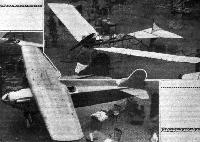
Fokker D.XIII
Вслед за неудачным одноместным истребителем D.XII был создан истребитель D.XIII, совершивший первый полет 12 сентября 1924 года. Создававшийся под требования возрождавшихся ВВС Германии, D.XIII являлся дальнейшим развитием истребителя D.XI, но уже с двигателем Napier Lion. Прототип отличался красивым внешним видом и, как оказалось, превосходными летными характеристиками.
Один из первых самолетов в серии из 50 D.XIII 16 июля 1925 года установил ряд мировых рекордов в скорости и грузоподъемности. Серийные самолеты окольными путями поставлялись в секретный учебный центр, организованный немцами в Липецке. Когда в 1933 году немцы покидали его, то оставшиеся 30 самолетов были переданы СССР.
ТАКТИКО-ТЕХНИЧЕСКИЕ ХАРАКТЕРИСТИКИ
Fokker D.XIII
Тип: одноместный истребитель
Силовая установка: один W-образный ПД Napier Lion XI мощностью 570 л. с. (425 кВт)
Летные характеристики: макс. скорость 270 км/ч на оптимальной высоте; крейсерская скорость 220 км/ч на оптимальной высоте; время набора высоты 1000 м - 1 мин 42 с; потолок 8000 м; дальность полета 600 км
Масса: пустого 1220 кг; максимальная взлетная 1650 кг
Размеры: размах крыла 11,00 м; длина 7,90 м; высота 2,90 м; площадь крыльев 21,47 Mj
Вооружение: два 7,92-мм пулемета LMG 08/15 в носовой части фюзеляжа
Описание:
- Fokker D.XIII
- Flight, December 1924
The Paris Aero Show 1924
Фотографии
-
Flight 1923-12 / Flight
The latest Fokker: This one-and-a-half 'plane is fitted with a Napier "Lion" engine, and has reached an altitude of 8,500 metres with a load of 1,000 lbs. Mijnheer Fokker claims that it is not essentially different in principle from the 1915 machine.
-
Flight 1925-08 / Flight
A FOKKER RECORD-BREAKER: The Fokker D.XIII has recently established four new world's records. Carrying a useful load of 500 kgs. (1,100 lbs.) the machine attained an average speed of 165-7 m.p.h., while with the same load and over a distance of 200 km., the average speed was 164-7 m.p.h. These speeds are stated also to be world's records for a machine carrying 250 kg. (550 lbs.) useful load. The pilot was Engineer Grase (inset), the Fokker chief test pilot. Great Britain's share in the records was provided by the Napier "Lion" engine, and it is interesting to note that both machine and engine were standard productions in every way.
-
Мировая Авиация 135
На момент создания это был один из самых быстрых истребителей в мире, и D.XIII разрабатывался для германских ВВС в рамках настолько секретной программы, что в США или Великобритании ее назвали бы "черной".
-
Авиация и Космонавтика 2006-03 / А.Лашков - Из истории собственных наименований воздушных судов России (2)
Самолет И.У.Павлова "Фоккер Д.XIII" с надписью "За В.К.П.(б)"
-
Flight 1924-12 / Flight
DUTCH MILESTONES AT THE PARIS SHOW: Alongside with the latest Fokker D XIII biplane - which is fitted with a Napier "Lion" engine - is exhibited the little wire-braced monoplane built and flown by Mr. Fokker in 1911. As will be seen above, Mr. Fokker believed in tubular metal construction even in those days.
Другие самолёты на фотографии: Fokker Spinne - Германия - 1910
-
Flight 1924-11 / Flight
PEACETIME PRODUCTION: A view inside the Fokker works at Amsterdam, showing a batch of Fokker D.XIII single-seater chasers. These machines, a specimen of which will be exhibited at the Paris Aero Show, are fitted with Napier "Lion" engines.
-
Flight 1924-12 / Flight
SOME FOKKER DETAILS: 1. View of the centre portion of the lower plane, showing fittings for attaching it to the fuselage. 2. One of the retractable radiators which are a feature of this machine.
- Фотографии






